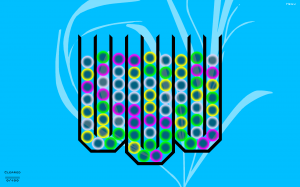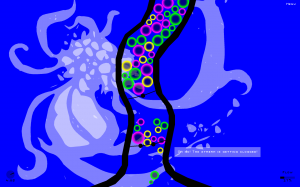Chains
 Too weary to launch into a major game on getting home from work, I instead look for something simple and casual that I can play on a laptop on the bus. I think I got Chains as part of the same Steam indie pack as Obulis, and, like Obulis, it seems designed for playing on phones — although I think I vaguely remember playing a PC demo for it some time back, or at least for something very similar, involving colored bubbles of varying size.
Too weary to launch into a major game on getting home from work, I instead look for something simple and casual that I can play on a laptop on the bus. I think I got Chains as part of the same Steam indie pack as Obulis, and, like Obulis, it seems designed for playing on phones — although I think I vaguely remember playing a PC demo for it some time back, or at least for something very similar, involving colored bubbles of varying size.
The basic mechanic is that bubbles fall from the top of the screen, and the player can delete them by tracing a chain — a path that joins together three or more like-colored bubbles. The chain can zigzag arbitrarily, but each link mush be sufficiently close to the last. I suppose it’s in the general family of “match-3” games like Bejeweled, but it differs from most in that it’s continuous rather than grid-based. I suppose Zuma fits that description as well, but there’s a little more physics going on here. Bubbles have weight and momentum, and bounce off each other somewhat.
Given the above mechanic, what does the game do with it? One can imagine various different goals and rules that work with deleting chains, and rather than choose one such, the developers here apparently chose to implement everything they could think of. There are 20 levels, and rather than just varying the board layout, each level is effectively a different game. When you complete a level and unlock the next, it asks you if you want to go on or stay on the same level. This would be a strange thing to ask in most level-based games, but here? Here it’s more like asking “Do you want to keep on playing Bejeweled or would you like to switch to Tetris instead?” I feel a little like structuring the game as a sequence of levels is unnecessary, that it would be better to just have them all unlocked from the beginning so that you can just choose whatever game you feel like from the main menu.
Incedentally, I choose the particulars of that simile — Bejeweled and Tetris — because those are more or less the paradigms for the first two levels. In the first, the bubbles are all the same size and contained in vertical columns, forcing a grid-like formation, and additional bubbles fall in only to replace the ones you delete. There’s no time pressure here, and no real risk of failure: you just keep making chains until you’ve deleted 100 bubbles, at which point you win. (At one point, I thought I had run out of possible moves, but that was because I hadn’t yet realized that you could connect chains across the solid-looking column walls.) Level 2 isn’t nearly as Tetris-like as level 1 is Bejeweled-like, but it shares the fundamentals: things piling up inexorably over time, with the player frantically trying to delete stuff before it piles up too far. The model here is that bubbles are constantly falling into a bin with a hinged bottom, held shut by a pulley and counterweight. If the weight of the bubbles exceeds that of the counterweight, the bubbles start to leak out the bottom and you lose. Which seems like a rather fancy way to say “don’t let things pile up too much in the bin”, but if you’ve already got the physics, why not?
 Level 3 is a quick one: it gives you several columns of bubbles in different sizes and point values (the value being determined by the size), and asks you to make a chain with a specific value. You might need to delete some stuff to make this possible, in which case, as in level 1, more bubbles will fall from the top to replace the ones deleted, but it’s basically a simple exercise in addition, similar to making change. The level after that is another time-pressure one, and difficult enough that I haven’t got past it yet. In a way, it’s the opposite of level 2: instead of keeping the bubbles on the screen, you’re told to “keep the stream flowing for five minutes”. The “stream” in question is a gently-curving frame with a couple of small barriers suspended in the middle to create blockages, which obviously you have to clear. The big difficulty with this is the ambiguity about what it means by “flowing”. Does it judge it by the rate at which things are entering from the top? The rate at which they’re leaving the bottom? The average downward velocity among all the bubbles? These are different goals, that require different approaches. There’s a (subtle and easy-to-miss) meter on the screen giving your current rate of flow, and you lose when it reports a flow rate of 0, but it seems to lag behind events a little; sometimes I lose at a moment when I’ve just cleared a major blockage and things are moving freely past both barriers again.
Level 3 is a quick one: it gives you several columns of bubbles in different sizes and point values (the value being determined by the size), and asks you to make a chain with a specific value. You might need to delete some stuff to make this possible, in which case, as in level 1, more bubbles will fall from the top to replace the ones deleted, but it’s basically a simple exercise in addition, similar to making change. The level after that is another time-pressure one, and difficult enough that I haven’t got past it yet. In a way, it’s the opposite of level 2: instead of keeping the bubbles on the screen, you’re told to “keep the stream flowing for five minutes”. The “stream” in question is a gently-curving frame with a couple of small barriers suspended in the middle to create blockages, which obviously you have to clear. The big difficulty with this is the ambiguity about what it means by “flowing”. Does it judge it by the rate at which things are entering from the top? The rate at which they’re leaving the bottom? The average downward velocity among all the bubbles? These are different goals, that require different approaches. There’s a (subtle and easy-to-miss) meter on the screen giving your current rate of flow, and you lose when it reports a flow rate of 0, but it seems to lag behind events a little; sometimes I lose at a moment when I’ve just cleared a major blockage and things are moving freely past both barriers again.
So far, both of the time-pressure levels are much more difficult than either of the others. What’s more, I don’t think the time-pressure levels are as well-suited for my purposes. Part of the appeal of casual games is the idea that you can pick them up and put them down whenever you feel like it, with no significant loss of state. The Stream level here requires you to play it continuously for five minutes. Sure, that’s not a large time commitment, but if I’m playing while I’m waiting for the bus, and the bus arrives four minutes into the level, I feel a little put out. Sure, you can pause the game, but that interferes with flow.
 Comments(0)
Comments(0)